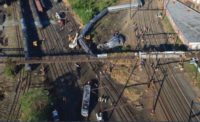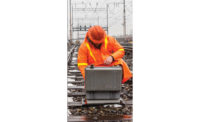
As the investigation continues into the May 12 Amtrak crash that claimed at least eight lives and injured scores of others, increased scrutiny is falling on positive train control, or PTC, a system that can prevent trains from exceeding speed limits. The train was found to be moving at twice the speed limit when it derailed.
The train-control issue affects engineering firms, which work for rail companies and agencies on PTC projects. At issue are proposals in Congress to extend the looming deadline for railroads to install the systems.
Amtrak has installed and is operating a version of PTC, called the Advanced Civil Speed Enforcement system, on parts of its Boston-to-Washington line in the Northeast Corridor.
The House Appropriations Committee said Amtrak informed the committee on May 14 that, at the time of the accident on the northeast stretch of track where the crash occurred in Philadelphia, the devices were installed but had not yet been activated because of delays related to getting the bandwidth necessary for upgraded radio signals.
Robert Sumwalt, a National Transportation Safety Board member who is heading the NTSB team probing the accident, said in a May 13 press conference that, shortly before Amtrak train No. 188 derailed, it was moving at 106 miles per hour, more than twice the 50-mph limit for the curve where the accident took place.
A 2008 federal rail statute mandates that PTC be installed by Dec. 31, 2015, on passenger-rail or commuter-rail main lines and on freight routes along which toxic substances are carried.
At a May 14 press conference at the accident site, Amtrak President Joseph Boardman said the railroad is “heartbroken” about the tragic accident and pledged to have PTC in place on the full Northeast Corridor by the end of the year.
According to the Federal Railroad Administration (FRA), on Amtrak's 457-mile-long Boston-to-Washington, D.C., corridor, PTC has been fully implemented on three segments, totaling about 205 miles: Boston to New Haven, Conn.; just south of New Brunswick, N.J., to Trenton; and a stretch in northeastern Maryland.
Industry officials say an extension of the PTC deadline for rail systems is necessary.
Michael Melaniphy, American Public Transportation Association president and CEO, in a May 14 statement said that, working with the FRA, the commuter, freight and passenger rail industries have “spent a significant amount of time and resources in developing this technology, and there is still work that remains to be done so that it is safe and effective.”
Melaniphy added, “It would be ill-advised to rush forward to meet a deadline, rather than taking the necessary time to implement this complex technology properly and safely.”
He also said, “Despite our best efforts, implementing PTC nationwide by the end of this year is not possible. This was never a realistic deadline set by Congress.”
The Association of American Railroads (AAR) says on its website, “Despite railroads’ best efforts, various technical and non-technical challenges make full development and deployment of PTC by 2015 impossible.” AAR said it supports an extension.
Kevin F. Thompson, an FRA spokesman, said in an emailed statement: "The Dept. of Transportation has long said that Positive Train Control is a game changer for safety. … It has been and remains one of the department's highest rail-related safety priorities."
Thompson added that DOT, knowing that railroads "were struggling both financially and technically to meet the deadline," twice asked Congress for authority to manage PTC deployment better and as safely and quickly as possible. DOT also twice has requested Congress to approve more funds to assist Amtrak and commuter-rail agencies to implement the deployment.





Post a comment to this article
Report Abusive Comment